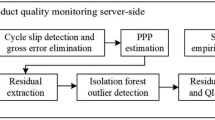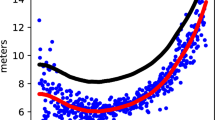The problem of maintaining synchronization of the national time scale of the Russian Federation UTC(SU) with the international coordinated time scale UTC within the specified limits is considered. Methods for comparing remote time scales, currently used in the State Primary Standard of the Units of Time, Frequency and the National time scale GET 1-2022, do not allow meeting the future requirements for UTC(SU) and UTC synchronization. Currently, there is no forecasting of the difference between the UTC(SU) and UTC, and for practical purposes, data from the official bulletins of the International Bureau of Weights and Measures (BIPM) are used. These data become available with a large time delay, which makes it difficult to ensure synchronization between the national and international time scales. The purpose of this study is to develop methods and algorithms that will ensure the fulfillment of future requirements concerning the limits of acceptable difference between the UTC(SU) and UTC scales. The following issues were addressed during the study: a method for comparing remote time scales has been selected, and an algorithm of timely automatic forecasting of the difference between the above time scales has been developed based on the selected comparison method with a time delay of no more than one day. A software that implements the proposed methods and algorithms has also been developed. The performance efficiency of the developed system has been analyzed by comparing the results with the estimates of the International Bureau of Weights and Measures. The obtained results will help ensure the functioning of the State Standard GET 1-2022 within the specified technical requirements.




Similar content being viewed by others
References
G. Panfilo and F. Arias, Metrologia, 56, 4, 042001 (2019), https://doi.org/10.1088/1681-7575/ab1e687.
G. Panfilo, A. Harmegnies, and L. Tisserand, Metrologia, 51, 3, 285–292 (2014), https://doi.org/https://doi.org/10.1088/0026-1394/51/3/285.
G. Petit, F. Arias, A. Harmegnies, G. Panfilo, and L. Tisserand, Metrologia, 51, 1, 33–39 (2014); https://doi.org/https://doi.org/10.1088/0026-1394/51/1/33.
P. Teunissen and O. Montenbruck, Handbook of Global Navigation Satellite Systems, Springer (2017).
J. F. Zumberge, M. B. Heflin, D. C. Jefferson, M. M. Watkins, and F. H. Webb, J. Geophys. Res., 102, B3, 5005–5017 (1997), https://doi.org/https://doi.org/10.1029/96JB03860.
P. Collins, S. Bisnath, F. Lahaye, and P. Heroux, Navigation, 57, 2, 123–135 (2010), https://doi.org/https://doi.org/10.1002/j.2161-4296.2010.tb01772.x.
D. Laurichesse, F. Mercier, J. P. Berthias, P. Broca, and L. Cerri, Navigation, 56, 2, 135–149 (2009), https://doi.org/https://doi.org/10.1002/j.2161-4296.2009.tb01750.x.
J. Geng, X. Meng, A. Dodson, and F. Teferle, J. Geodesy, 84, 569–581 (2010), https://doi.org/https://doi.org/10.1007/s00190-010-0399-x.
M. Ge, G. Gendt, M. Rothacher, C. Shi, and J. Liu, J. Geodesy, 82, 7, 389–399, https://doi.org/10.1007/s00190-007-0187-4.
J. Delporte, F. Mercier, D. Laurichesse, and O. Galy, Int. J. Navig. Obs. (2008), https://doi.org/https://doi.org/10.1155/2008/273785.
G. Panfilo and F. Arias, IEEE Ultrason. Ferroelectr. Freq. Control, 57, 1, 140–150 (2010), https://doi.org/https://doi.org/10.1109/TUFFC.2010.1390.
W. Riley and D. Howe, Handbook of Frequency Stability Analysis, Special Publication (NIST SP), National Institute of Standards and Technology, Gaithersburg, MD (2008).
Author information
Authors and Affiliations
Corresponding author
Additional information
Translated from Metrologiya, No. 9, pp. 40–44, September, 2022.
Rights and permissions
Springer Nature or its licensor (e.g. a society or other partner) holds exclusive rights to this article under a publishing agreement with the author(s) or other rightsholder(s); author self-archiving of the accepted manuscript version of this article is solely governed by the terms of such publishing agreement and applicable law.
About this article
Cite this article
Karaush, A.A. Automatic System for Remote Time-Scale Comparison and Prediction Using Carrier-Phase Measurements of the Global Navigation Satellite Systems. Meas Tech 65, 660–665 (2022). https://doi.org/10.1007/s11018-023-02136-6
Received:
Accepted:
Published:
Issue Date:
DOI: https://doi.org/10.1007/s11018-023-02136-6




